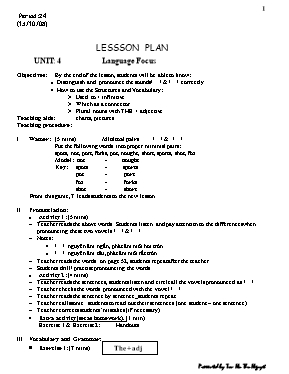Giáo án Tiếng Anh Lớp 10 (Cơ bản) - Tiết 24
Bạn đang xem tài liệu "Giáo án Tiếng Anh Lớp 10 (Cơ bản) - Tiết 24", để tải tài liệu gốc về máy bạn click vào nút DOWNLOAD ở trên

Period :24 (13/10/08) LESSSON PLAN UNIT: 4 Language Focus Objectives: By the end of the lesson, students will be able to know: Distinguish and pronounce the sounds/ / & / / correctly. How to use the Structures and Vocabulary: Used to + infinitive Which as a connector Plural nouns with THE + adjective Teaching aids: charts, pictures Teaching procedure: Wamer: (5 mins) Minimal pairs / / & / / Put the following words into proper minimal pairs: spots, not, port, forks, pot, nought, short, sports, shot, fox. Model: not - nought Key: spots - sports pot - port fox - forks shot - short From this game, T leads students to the new lesson. Pronunciation: Activity 1: (5 mins) Teacher reads the above words. Students listen and pay attention to the differences when pronouncing these two vowels / / & / / Notes: / / nguyên âm ngắn, phát âm môi hơi tròn. / / nguyên âm dài, phát âm môi rất tròn. Teacher reads the words on page 52, students repeat after the teacher. Students drill/ practise pronouncing the words Activity 2: (4 mins) Teacher reads the sentences, students listen and circle all the vowels pronounced as / /. Teacher checks the words pronounced with the vowel / /. Teacher reads the sentence by sentence _students repeat Teacher calls some students to read out their sentences. (one student – one sentence) Teacher corrects students’ mistakes (if necessary) Extra activity (set as homework). (1 min) Exercise 1 & Exercise 2: Handouts Vocabulary and Grammar: Exercise 1: (7 mins) The + adj Teacher sticks the picture on the blackboard ask: Are they rich or poor? Expected answer: poor So the government should take care of the poor( poor people). Teacher asks students about the part of speech of in the first sentence. Expected answer: It is an adj. How about in the second sentence? Expected answer: It is a plural noun ( referring to people ). Teacher explains another usage of this word. THE + Adjective → Plural Noun (referring to people) Teacher asks students to read the words on page 52 and gives its meaning (if necessary). Teacher asks students to do this exercise in pairs Teacher asks students to read out the sentences. Extra activity: ( set as homework) (1 min) Teacher asks each student to find at least two other nouns having this structure: THE + Adj then make their own sentences. Suggested words and sentences: the mute, the dumb, the blind, the disabled, the deaf, the homeless, the dead, the old, the Vietnamese, Ex: Braille is a system of reading and writing by touch for the blind. The government takes care of the old and the homeless. She has spent her life caring for the mute / the disabled. Many people were killed in the plane crash. The bodies of the dead were taken away. The injured were taken to hospital. People who cannot speak are called the mute. Exercise 2: (7 mins) Used to + inf Teacher draws the pictures on the blackboard 40 cigarettes a day Dennis 2004 Dennis 2006 Two years ago, Dennis smoked 40 cigarettes a day. Did he smoke a lot in the past? →Yes. Was it a habit? → Yes Does he have this habit now? → No So , when we talk about a past habit that is finished, what do we use? → used to * Dennis used to smoke 40 cigarettes a day two years ago. Form: S + used to + inf +. Did + S + use to + inf + ? S + didn’t use to + inf + Meaning: đã từng Use: This structure is used to talk about a habit in the past but no longer happens at present. Pronunciation: used to / / or / / Teacher asks students to do the exercise individually then exchange their answers with their partners. Teacher calls some students to read out their sentences. The whole class correct the mistakes if necessary. Extra activity: (3 mins) (pair work) Teacher asks each student to make at least two sentences about what he/she used to do when he/she was young. Then exchange their sentences with their partners. Model: I used to cry when I went to school at six. I used to play with dolls when I was a little girl. Teacher calls some students to read out their own sentences. Exercise 3: Connective which (6 mins) Teacher asks students to read the sentences in columns A and then answer the questions: Are they complete sentences? → Yes. Are they meaningful? →Yes How about the sentences in column B? Are they meaningful? → No Comments: The sentences in column A are complete and meaningful sentences. The sentences in column B add more information or remarks about what have been mentioned before Teacher asks students to look at the example and reminds them of the comma before WHICH. Teacher asks students to do the exercise in pairs. Teacher calls some students to read out the sentences. Teacher corrects if necessary. Extra activity: (4 mins) Groups of four one student makes a sentence or declares something. The others give comments, remarks or explanation by adding a clause beginning with WHICH. Model: S1: According to the weather forecast, it’s going to rain tomorrow. S2: It’s going to rain tomorrow, which means we can’t go on a picnic. S3: It’s going to rain tomorrow, which makes it difficult for me to visit my grandmum. S4: It’s going to rain tomorrow, which is very good for the crop. Homework: (2') Do all the exercises given. Prepare Unit 5: Reading in advance.
Tài liệu đính kèm:
 giao_an_tieng_anh_lop_10_co_ban_tiet_24.doc
giao_an_tieng_anh_lop_10_co_ban_tiet_24.doc





